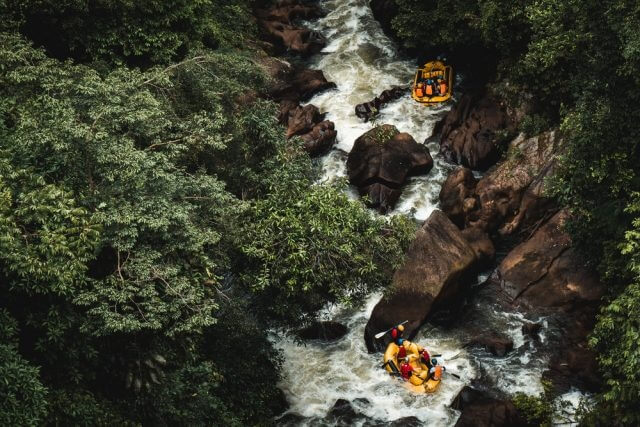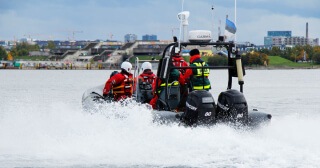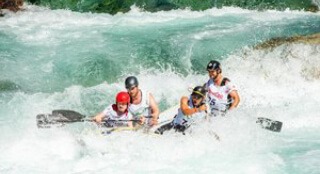Swiftwater Rescue Technician Training With NFPA Certification

If SRT-1 Certification is the training you are planning to undertake, Crux Rescue can cater to your training needs, teaching you a course in or near your city in Oregon or Washington. If several on your staff need the same rescue course, it is highly likely Crux Rescue can teach the course right in your city.
We will discuss, herein, some of the subject matter that can be included in a course one will take for SRT-1 certification. While not all of this will be included in a typical course, most of it is. While each class has core, required elements of instruction that are included in order to fulfill standardized requirements, the study can include several additional nuggets; those subjects that are perceived to be a special fit for the attending students as they relate to the rescues they may be called upon to perform on the behalf of future victims within the unique environment of the community or area they serve. This key to the uniqueness of their environment comes into play when considering the geological features in the rivers and waterways in their area where recreation and other activities are frequently permitted.

Swiftwater Rescue In The Hot Zone
There is one question interested students may have when considering this specific course. “Is this class ideal for technicians who will be responding in the hot zone?” The answer is, yes. If hot zone rescues will be included in your response itinerary, you’ll want to register for this course. Crux Rescue’s NFPA-compliant Swiftwater Rescue Technician Unit 1 (SRT:TL) course is an SRT-1 course and it is designed specifically for Fire Rescue professionals and Search & Rescue (SAR) personnel.
Personnel The Swiftwater Rescue SRT-1 Pertains To
- Firefighters
- Search and Rescue
- Emergency managers
- Disaster officers
- Disaster response volunteers
Swiftwater Rescue & NFPA Standards
Another question may be, “What sets the SRT-1 (SRT:TL) class apart from other swiftwater rescue courses?”
The NFPA compliance is the component that makes this class different from the standard swiftwater rescue course. NFPA compliance is the bedrock of the Swiftwater Technician level. Incidentally, Swiftwater Technician level is a required training level for inclusion on a Federal Emergency Management Agency Swiftwater/Flood Search and Rescue Team (at all team levels). If your unit is involved in FEMA disaster response, this is a course you’ll be required to take.
Swiftwater Rescue SRT-1 Fundamentals, Skills & Techniques
An SRT-1 course prepares and equips students with the fundamentals of rescue in moving water and is recommended for those who will need to perform in-water rescues when they respond to a call. Students will learn some array of practicum in swiftwater rescue as it relates to hydrology, river classifications, scene assessment & management and site control.
The personal skills involved can include swimming in moving water and self-rescue. Rescue scenarios practiced may include boat rescue, in-water rescues and shore rescue for extricating accident victims from the water. Skills and technique for swiftwater rescues in river and flood situations are usually covered in good detail. Student instruction can educate participants in the basics of boat handling, fundamental rope rescue technique, anchoring systems and mechanical advantage principles.
Typical Swiftwater Rescue SRT-1 Course Topics
These may vary according to student experience and unique rescue environments.

- Swiftwater rescue gear selection
- Equipment preparation for swiftwater rescue deployment
- Swiftwater incident scene assessment
- On-scene leadership responsibilities
- Site control & management
- Team organization & complementary roles
- Personnel and group communication
- Search techniques
- Boating maneuvers and tactics
- Handling inflatable boats by paddle and tether
- Swiftwater use of climbing and technical gear
- Throw bags & rope rescue techniques
- Rope rescue system applicable to the scene
- Basic rope work, knots and anchors
- Mechanical advantage systems 3:1, 4:1, 9:1
- Strainer dangers and best practices
- Victim stabilization
- Victim response assessment
- Foot entrapment extrication
- Whitewater swimming
- Swimmer rescues
- Contact Swims
- Tethered swimmer
- Self-rescue skills
- Techniques of crossing shallow and fast-moving water
- Negotiating river hazard obstacles
Swiftwater Rescue SRT-1 Classroom To Riverside Ratio
If you register for instruction in this course with Crux Rescue, the ratio of classroom time to river time is 1:2. The first day of class is dedicated to the classroom discussions of the fundamentals of river rescue. The following two days convene on the river for hands-on practicing of rescue skills. Some training companies may present the course in more of a 50/50 split between the classroom and the river.
Swiftwater Rescue Personnel Not Needing SRT-1 Certification
If you work in a Department of Water Resources (DWR), with Fish and Game or if you are a fishery biologist, environmental consultant or other professional who works around rivers and streams, in most cases you won’t need an NFPA compliant course. Additionally, river guides and those who are instructors of kayakers, stand up paddle boarders (SUP) or wake boarders, you also will not need this NFPA compliant course.
Strongly Consider Crux Rescue’s SRT-1 Swiftwater Rescue Certification Course
If you need to be certified in swiftwater rescue with SRT-1 certification, we encourage you to look at Crux Rescue’s Swiftwater Rescue Technician Unit 1 (SRT:TL) training course to see the information they include and cover in the class. You can always contact Crux Rescue for further information about swiftwater rescue or to inquire if you are interested in scheduling a class in your area.


